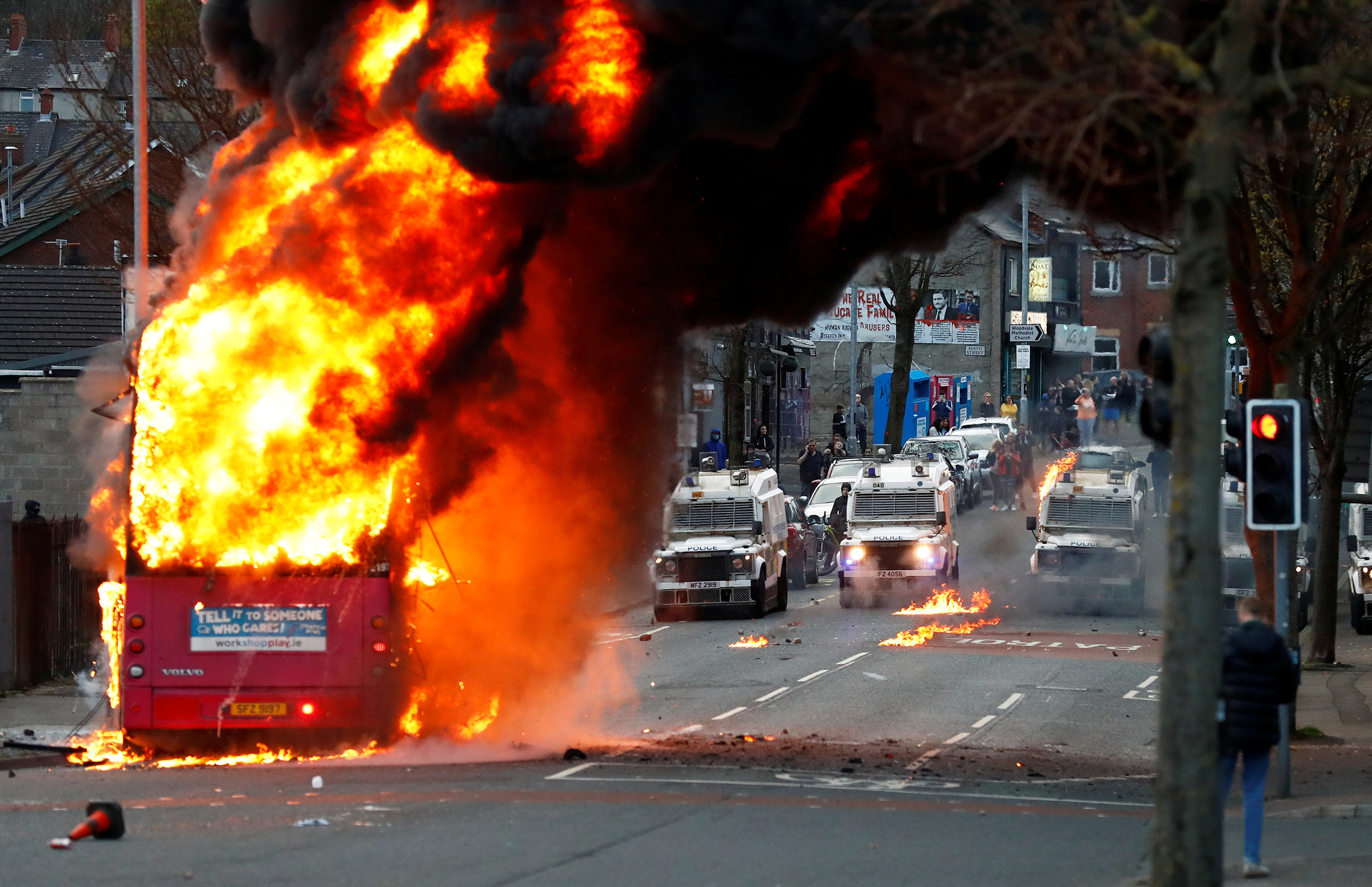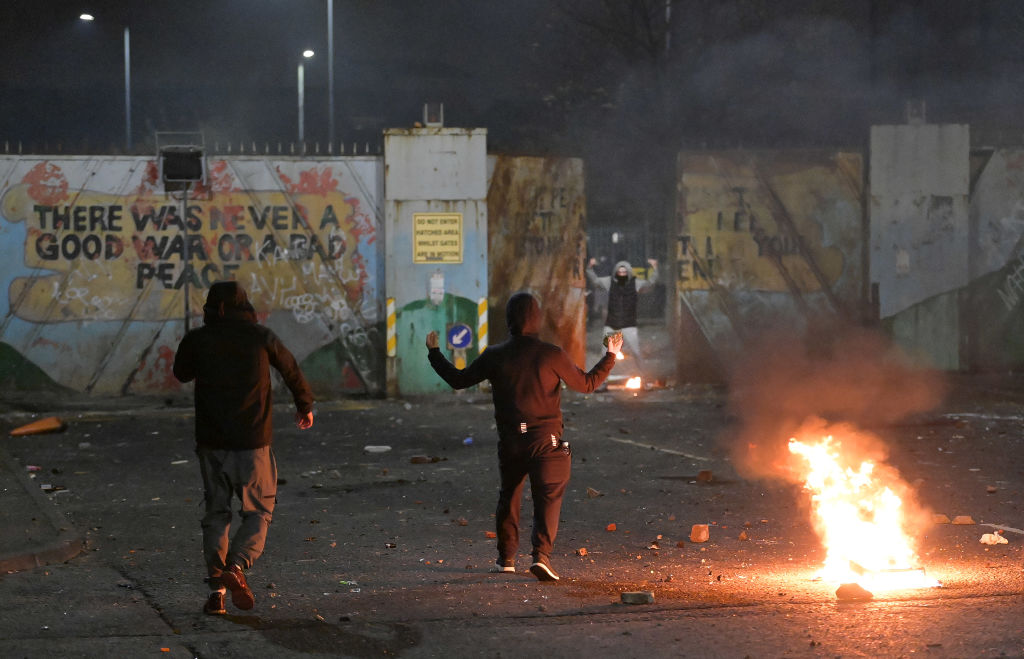
Scenes of violence on the streets of Northern Ireland this week prompted many to recall the country’s troubled past: rioters pelting rocks at police, young men with covered faces throwing petrol bombs and bricks.
Videos shared on social media Thursday showed a driverless bus rolling down a Belfast street with its doors open. Two young men, dressed in black, pelt it with Molotov cocktails. Another video taken minutes later shows the vehicle engulfed in flames. The driver, chased from his cockpit seconds before, escaped unhurt but shaken.
Read More: Brexit Could Jeopardize Peace in Northern Ireland—and America Is Ignoring It
Seven nights of rioting on the streets of the Northern Irish capital have left 74 police officers injured, in what observers say is the country’s worst violence in years. Late Thursday, the White House appealed for calm. “We are concerned by the violence in Northern Ireland,” President Joe Biden’s spokeswoman Jen Psaki said in a statement, adding that Biden hoped for a “secure and prosperous Northern Ireland in which all communities have a voice and enjoy the gains of the hard-won peace.”
What’s the background to the Northern Ireland riots?
Northern Ireland’s population is divided between mostly-Protestant Unionists, who want to maintain Northern Ireland’s status as part of the United Kingdom, and mostly-Catholic Nationalists, who want political unity with the Republic of Ireland. Now, more than two decades after the Good Friday Agreement peace deal brought the years of sectarian “Troubles” in Northern Ireland to an end, new tensions arising from Brexit, organized crime and political patronage are stoking old rivalries and anxieties.
While the causes for the violence are multifaceted, observers say it is underpinned by a sense of frustration in the Unionist community. “There has been this brewing fear on the Unionist side that they are not as British as people in Birmingham,” says Feargal Cochrane, author of Northern Ireland: The Fragile Peace. “A fear that there are different rules applying to them.”

The frustration was triggered by a key Brexit milestone that was passed in January.
During the years of interminable negotiations over Britain’s exit from the European Union, both sides wrangled long and hard over the delicate Irish border. The border was once heavily militarized, a symbol of the decades of sectarian violence that scarred the island. But a central tenet of the 1998 Good Friday Agreement was that there would be no physical boundary between the Republic and Northern Ireland. Brexit presented a problem: the Irish border, previously an invisible interface between two E.U. countries, would after Brexit become the U.K.’s only land border with the E.U., causing a problem for the crossing of goods into the bloc’s heavily-regulated market.
Read More: Brexit Has Revived the Prospect of a United Ireland. Could It Actually Happen?
The U.K. government’s solution to that problem was checks on goods not along the land border, but effectively creating a “sea border” for goods traveling between Northern Ireland and the rest of the U.K. That came into effect on Jan. 1 this year, a Brexit milestone that was heralded in London as a great success. However, while the arrangement avoids a hard land border, as campaigned for by the Irish government, it has left many in Northern Ireland feeling like an unequal part of the U.K. “As far as the rest of the U.K. population is concerned, Brexit is done and dusted,” says Peter Cardwell, a former special advisor to two U.K. government Northern Ireland Secretaries. “But in Northern Ireland, many people feel that the U.K. government has left them behind.”
What sparked the Northern Ireland riots?
While Brexit has caused simmering underlying tensions, the seven nights of violence in Belfast were sparked by a decision from Northern Ireland’s Public Prosecution Service to not prosecute 24 high-ranking members of Sinn Fein, the nationalist party, who had breached COVID-19 regulations by attending a funeral for Bobby Storey, a prominent member of the Irish Republican Army (IRA), a paramilitary group that played a key role in the violence of the Troubles.
“What really infuriated people was the decision not to follow up on the breach of COVID-19 rules at the funeral,” says Laura Sudulich, a researcher at the University of Essex who studies post-conflict societies. “It was like there was one rule for certain people and one rule for everyone else. That feeling really sparked the tensions.”
Read More: A Journalist’s Killing in Northern Ireland Comes as Tensions Threaten to Boil Over
The violence is mainly centered around Unionist areas of Belfast, in part of the city where Unionist and Nationalist working class communities live in close quarters. A video shared on Twitter showed black-clad young men rioting beside a “peace wall” in North Belfast, with a mural proclaiming that “there was never a good war or a bad peace.” The video shows a firebomb breaking against the wall, engulfing it in flames.
How is Brexit affecting Northern Ireland?
The frustration over the attendance at the funeral by Sinn Fein representatives added to the anger felt by many Unionists about the new trade rules that they feel separate them from the rest of the U.K., to which they want to remain bound. To move some products from mainland Britain to Northern Ireland, you now need specific export licences. “If you’re transporting a truck that has different products on it, then you’ll need different bits of paperwork for those products,” says Cochrane. “It means more cost and more delay for a lot of produce.”
Cardwell, who as a former U.K. government adviser was involved in the Brexit negotiations over the Irish border, says that one of the “real ironies” of the situation is that trade between Great Britain and Northern Ireland has boomed in recent months—but disproportionately for big businesses who can handle the paperwork and expenses. “A lot of the business community is happy enough,” he says. “The real problems are being felt by small businesses who are struggling to import or export things like plants across the sea border.”
More protests are planned for the coming days, but Cardwell predicts tensions will likely simmer down soon, as police begin to assert themselves and as the Easter school break comes to an end, bringing young rioters back into the classroom. As for future tensions in the North? There is a fear among the Unionist community that there could be an eventual push toward a united Ireland. The Good Friday Agreement does include a provision for holding a referendum about unifying Northern Ireland with the Republic, provided there is a clear mandate. “It’s a long time before we get to that point,” says Cardwell, who is a Unionist. “But people are starting to talk about it, and have sensible, mature conversations about what a united Ireland might look like.”
The government’s handling of Brexit, he suggests, may be shifting public opinion. “If this feeling persists that London doesn’t care about Northern Ireland, then the question arises: who are you being loyal to and why are you being loyal to them? And would things be worse in a united Ireland?”
More Must-Reads From TIME
- The 100 Most Influential People of 2024
- Coco Gauff Is Playing for Herself Now
- Scenes From Pro-Palestinian Encampments Across U.S. Universities
- 6 Compliments That Land Every Time
- If You're Dating Right Now , You're Brave: Column
- The AI That Could Heal a Divided Internet
- Fallout Is a Brilliant Model for the Future of Video Game Adaptations
- Want Weekly Recs on What to Watch, Read, and More? Sign Up for Worth Your Time
Write to Billy Perrigo at billy.perrigo@time.com